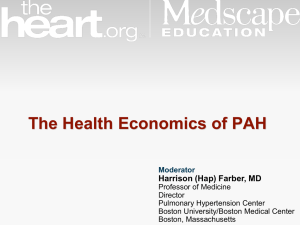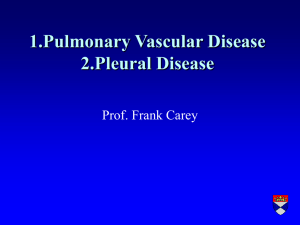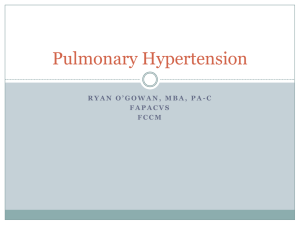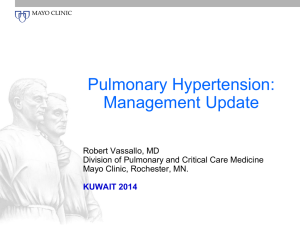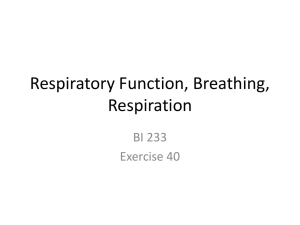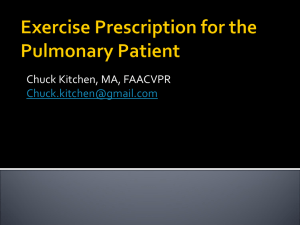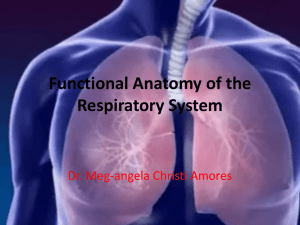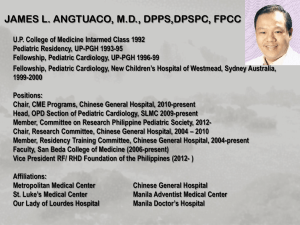Pulmonal hypertensjon
advertisement
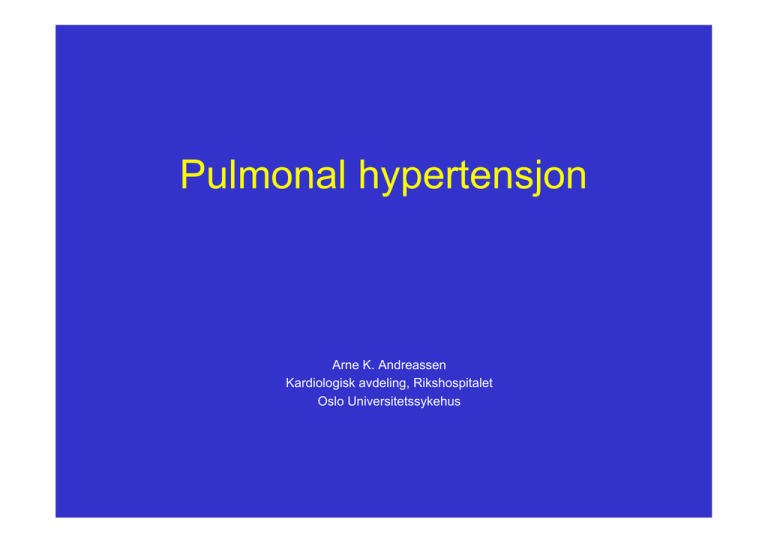
Pulmonal hypertensjon Arne K. Andreassen Kardiologisk avdeling, Rikshospitalet Oslo Universitetssykehus Clinical classification of pulmonary hypertension 1. Pulmonary arterial hypertension (PAH) 2. Pulmonary hypertension due to left heart disease 3. Pulmonary hypertension due to lung diseases and/or hypoxemia 4. Pulmonary hypertension due to chronic thromboembotic and/or embolic disease 5. Pulmonary hypertension with unclear and/or multifactorial mechanisms Hemodynamic definitions of PH by RHC Definition Characteristics Clinical group(s) Pulmonary hypertension (PH) Mean PAP ≥ 25 mmHg All Pre-capillary PH Mean PAP ≥ 25 mmHg PWP ≤ 15 mmHg CO normal or reduced 1. Pulmonary arterial hypertension 3. PH due to lung diseases 4. Chronic thromboembolic PH 5. PH with other and/or multifactorial mechanisms Post-capillary Mean PAP ≥ 25 mmHg PWP ≥ 15 mmHg CO normal or reduced 2. PH due to left heart disease Passive Reactive (out of proportion) TPG ≤ 12 mmHg TPG ≥ 12 mmHg PAP in healthy subjects 47 publications 1187 subjects >50 yrs 18-30 yrs Kovacs et al. Eur Respir J 2009; 34: 888-94 The pulmonary artery catheterright heart catheterization Chatterjee K. Circulation 2009; 119: 147-52 Clinical classification of pulmonary hypertension 1. Pulmonary arterial hypertension (PAH) 2. Pulmonary hypertension due to left heart disease 3. Pulmonary hypertension due to lung diseases and/or hypoxemia 4. Pulmonary hypertension due to chronic thromboembotic and/or embolic disease 5. Pulmonary hypertension with unclear and/or multifactorial mechanisms 2. PH due to left heart disease 2.1 Systolic dysfunction 2.2 Diastolic dysfunction 2.3 Valvular disease RV failure added to LV failure N = 377 VVEF < 35% Ghio S et al. J Am Coll Cardiol 2001; 37: 183-8 PH in heart failure with preserved EF Lam CS et al. J Am Coll Cardiol 2009; 53: 1119-26 LV dysfunction and development of pulmonary hypertension Moares DL et al. Circulation 2000; 102: 1718-23 Clinical classification of pulmonary hypertension 1. Pulmonary arterial hypertension (PAH) 2. Pulmonary hypertension due to left heart disease 3. Pulmonary hypertension due to lung diseases and/or hypoxemia 4. Pulmonary hypertension due to chronic thromboembotic and/or embolic disease 5. Pulmonary hypertension with unclear and/or multifactorial mechanisms 1. Pulmonary arterial hypertension 1.1 Idiopathic 1.2 Heritable 1.2.1 BMPR 2 1.2.2 ALK 1, endoglin (with or without HHT) 1.2.3 Unknown 1.3 Drugs and toxins induced 1.4 Associated with (APAH) 1.4.1 1.4.2 1.4.3 1.4.4 1.4.5 1.4.6 Bindevevssykdommer HIV infection Portal hypertension Congenital heart disease Schistosomiasis Chronic hemolytic anemia 1.5 Persistent pulmonary hypertension of the newborn 1` Pulmonary veno-occlusive disease and/or pulmonary capillary hemangiomatosis Patogenese ved PAH Gaine S. JAMA 2000; 284: 3160-4 Ekkokardiografi og histologi Survival in IPAH Percentage surviving Formula for survial: 100 A(x,y,z) = e(0.007352x + 0.0526y – 0.3275z) 80 Where x = MAP y = RAP z = CI 60 40 20 1 2 3 4 5 Years of follow-up D`Alonzo GE et al. Ann Intern Med 1991; 115: 343-9 PAH: A progressive disease Pre-symptomatic/ Compensated Symptomatic/ Decompensating Declining/ Decompensated CO Symptom Threshold PAP PVR s tom p Sym Right Heart Dysfunction Time Hill NS. Pulmonary Hypertension Therapy. 1st Ed. 2006:7-28 Prevalence of PAH French PAH registry; 674 patients: 15 cases/million adult inhabitants Scottish Morbidity Record Scheme: 52 cases/million Σ: 25-50 cases/million inhabitants(?) Humbert M et al. Am J Respir Crit Care Med 2006; 173: 1023-30 Clubbing in Eisenmenger syndrome Digital Vascular Injury in Scleroderma Diagnostic algorithm for PAH McLaughlin VV et al. Circulation 2006; 114: 1417-31 Right-heart catheterization Akutt vasodilatasjonstest Respondere Ikke – respondere MAP og PAR reduseres til nær normale verdier Ca-blokkere Endotelinblokkere PDE-5 blokkere Prostaglandiner Functional testing in PAH Miyamoto S et al. Am J Respir Crit Care 2000; 161: 487-92 Wensel R et al. Ciculation 2002; 106: 319-24 NT-proBNP and survival Andreassen AK et al. Am J Cardiol 2006; 98: 525-9 Targets for current therapies in PAH Targeted drug therapy in Norway Drug NYHA-class Dosage Calcium channel blockers Endothelin receptor antagonists Ambrisentan Bosentan Sitaxentan II, III II, III III 5-10 mg X 1 125 mg X 2 100 mg X 1 Phosphodiesterase type-5 inhibitors Sildenafil II, III 20 mg X 3 Prostanoids Epoprostenol (iv) Iloprost (inh) Treprostinil (iv,sc) III-IV III-IV III 15-50 ng/kg/min 10µg X 6-9 inh 20-50 ng/kg/min Observed and estimated survival in IPAH N = 32 Andreassen AK et al Akseptert for Tisskr Nor Legeforen 2010 Baseline IPAH hemodynamics RA (mmHg) 7±4 mPAP (mmHg) 57±13 PWCP (mmHg) 7±4 Svo2 (%) 59±9 HR (beats/min) 80±11 Sao2 (%) 94±3 CO (l/min) 3.3±0.9 CI (l/min/m2) 1.8±0.5 PVR (WU) 16.1±5.3 Peak VO2 (ml/kg/min) 11.7±4.3 NT-proBNP (pmol/l) 373±451 Meta-analysis of randomized trials in PAH Trials: 21 N=3140 Duration 14.3 weeks All-cause mortality Among controls: 3.8% Reduction in mortality: 43% (RR 0.57; 95% CI 0.35-0.92; p=0.023) Galié N et al. Eur Heart J 2009; 30; 394-403 Lung transplantation Trulock EP et al. J Heart Lung Transplant 2005; 24: 956-67 Clinical classification of pulmonary hypertension 1. Pulmonary arterial hypertension (PAH) 2. Pulmonary hypertension due to left heart disease 3. Pulmonary hypertension due to lung diseases and/or hypoxemia 4. Pulmonary hypertension due to chronic thromboembotic and/or embolic disease 5. Pulmonary hypertension with unclear and/or multifactorial mechanisms Cor pulmonale (WHO 1963): ”hypertrophy of the RV resulting from diseases affecting the function and/ or structure of the lungs, except when these pulmonary alterations are the result of diseases that primarily affect the left side of the heart, as in congenital diseases” Høyrekateterisering (m/1 L O2) RA (mmHg) 6 MAP (mmHg) 27 PCV (mmHg) 7 CI (L/min/m2) 2,2 PAR (WU) 4,9 HR (min-1) 84 AP metn.(%) 57 Ao metn.(%) 90 PH severity in emphysema N = 215 mPAP = 27±8 mmHg 4% with mPAP > 45 mmHg Thabut G et al. Chest 2005; 127: 1531-6 Clinical classification of pulmonary hypertension 1. Pulmonary arterial hypertension (PAH) 2. Pulmonary hypertension due to left heart disease 3. Pulmonary hypertension due to lung diseases and/or hypoxemia 4. Pulmonary hypertension due to chronic thromboembotic and/or embolic disease 5. Pulmonary hypertension with unclear and/or multifactorial mechanisms Pulmonary angiograms Thrombendarterectomy Fedullo PF et al. N Engl J Med 2001: 1465-72 Thrombendarterectomy Auger W/Newman JH. Am J Resp Crit Care 2005; 172; 1072-7
